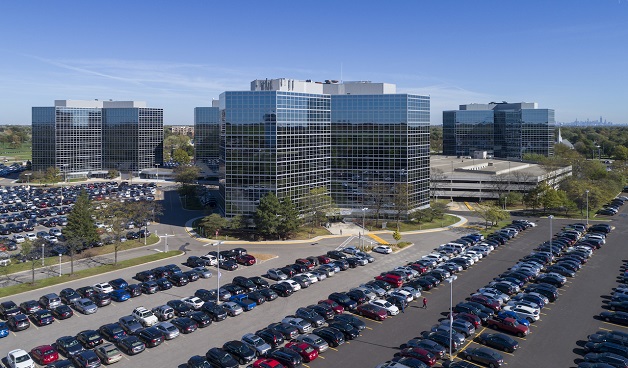 Blackstone recently sold Westbrook Corporate Center in Westchester for $132 million, or about $113 per square foot, to Group RMC.
Blackstone recently sold Westbrook Corporate Center in Westchester for $132 million, or about $113 per square foot, to Group RMC.
CHICAGO—Downtown landlords may have recently completed a number of blockbuster office sales, but this year suburban property sales have eclipsed ones in the CBD. During the last six months (through May 2018) office investors in the Chicago metro area spent a total of $2.9 billion, according to a new report from Savills Studley, a 51% increase compared to the previous six-month total of $1.9 billion, with suburban sales totaling $1.5 billion.
“It's a good time for suburban landlords to cash out if they have completed a lot of leases,” Jon Azulay, corporate managing director at Savills, tells GlobeSt.com. And the buyers are a real mix. Some want properties such as Continental Towers in Rolling Meadows, a 911,341-square-foot complex that struggled with high vacancy during the recession but was brought back to life by GlenStar Properties after the company bought it in 2013 for $58.5 million. GlenStar and its partner Walton Street Capital spent about $23 million on improvements and are now selling the property for $125 million, according to the Savills report, although GlenStar officials say they will stay on.
Other buyers, Azulay adds, want true value-add properties that need renovations. Franklin Partners, in a joint venture with Bixby Bridge Capital, recently bought OfficeMax's former headquarters at 263 Shuman Blvd. in Naperville and plans to redevelop the 350,000-square-foot building into a socially-activated, multi-tenant property. It was initially developed in 1987 for AT&T and is one of many suburban corporate headquarters that needs a redesign to meet the desires of modern tenants.
GlenStar and PGIM Real Estate also just sold their 834,893-square-foot Presidents Plaza, a pair of class A office buildings at 8600 and 8700 W. Bryn Mawr Ave. near O'Hare Airport, for $147 million to New York City-based Angelo, Gordon & Co., although GlenStar decided to stay on as a minority partner. GlenStar and PGIM spent $15 million in capital renovations and brought occupancy up to 92.4%, but the new ownership still plans to update the fitness center and add outdoor spaces to an existing tenant lounge.
And some developers see opportunities in big corporate campuses such as the McDonald's complex in Oak Brook. These sprawling developments, now considered obsolete, are likely targets for demolitions that will allow new residential or other uses.
“The plight of the suburban campus has captured the attention of even state legislators,” according to the Savills report. “State Representative Fred Crespo has proposed the “Big Empties Site Act” that would offer tax breaks for developers.”
Azulay believes the suburban market could also see a healthy amount of investment activity in the second half of 2018. The Blackstone Group, for example, has put its O'Hare International Center in Rosemont on the market for about $145 per square foot, he says. It already has a set of interested buyers for these two buildings at 10255 and 10275 W. Higgins Rd. and a transaction “will probably close this quarter.”
Blackstone, which also owns Chicago's Willis Tower, has already unloaded much of its suburban portfolio, he adds. Most recently, it sold Westbrook Corporate Center in Westchester for $132 million, or about $113 per square foot, to Group RMC, an active investor that also just acquired the 11-building Oak Creek portfolio in Lombard.
Of course, not every submarket can expect to attract buyers. “The Northwest is still a bloodbath, especially if you go further west,” Azulay says. And even though the O'Hare area has gotten quite tight, with a class A availability rate of just 15.0%, it's the suburbs' smallest submarket and won't present many more opportunities for investors.
But suburban investments do make sense for many buyers. They will most likely get better cap rates than similar properties in the CBD, and still get the benefits of investing in what is considered a core market. “Groups with money are always looking to place it in the right spots,” Azulay says.
© Touchpoint Markets, All Rights Reserved. Request academic re-use from www.copyright.com. All other uses, submit a request to [email protected]. For more inforrmation visit Asset & Logo Licensing.







